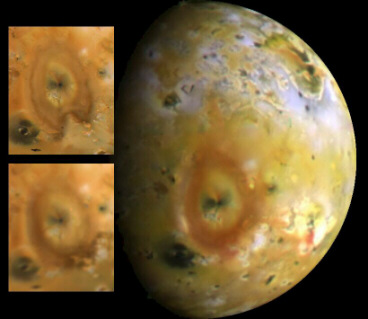Researchers at Washington University in St. Louis recently showed that lava spewing from volcanoes on Io's surface is so hot that it vaporizes elements such as potassium, nitrogen, and iron into the moon's atmosphere.
Yoram Ored, Galileo

Direct link to this page: https://www.hayadan.org.il/io120205.html
What is the body with the highest surface temperature in the solar system, other than the sun itself, which is a body that produces its own energy through processes of nuclear fusion? It turns out that this title is reserved for Io, one of the largest moons of the giant planet Jupiter, a moon discovered by Galileo nearly four hundred years ago, in 1610, using his telescope.
It has been known for years that Laio has vigorous volcanic activity. More than twenty years ago, Voyager 1 discovered such volcanic activity on the surface of Io, and later it turned out to be the most volcanically active body in the entire solar system. Over a hundred active volcanoes have so far been discovered on the island and the temperature of some of them reaches one thousand six hundred degrees Celsius.
This is a temperature hundreds of degrees higher than the temperature of volcanoes on Earth, where the temperature of volcanoes such as Kilahue reaches about a thousand degrees. It is the innermost moon of the planet Jupiter (among the "Galilean" moons, discovered by Galileo at the beginning of the 17th century) and its powerful volcanic activity is explained by its great proximity to the giant planet (Io's distance from Jupiter is 422,000 kilometers).
The close proximity causes powerful tidal forces, due to Jupiter's great pull. The great strength of the tidal forces in Io causes warming. Researchers at Washington University in St. Louis recently showed that the lava released from volcanoes on Io's surface is so hot that it vaporizes elements such as potassium, nitrogen and iron into the moon's atmosphere.
Question marks accompany the moon Io. One of the questions is how the moon, which is about the size of our moon (the diameter of Io is 3630 kilometers compared to our moon's 3476 kilometers) is able to maintain such high temperatures on its surface without melting almost completely.
Another question is how it is able to maintain on its surface a lithosphere (the lithosphere is the earth's crust or another celestial body) strong enough to support on its surface such high mountains, which reach a height greater than that of Mount Everest on the surface of the earth.
Yedan was right
https://www.hayadan.org.il/BuildaGate4/general2/data_card.php?Cat=~~~81413014~~~19&SiteName=hayadan
